buttons SKODA YETI 2009 1.G / 5L Owner's Manual
[x] Cancel search | Manufacturer: SKODA, Model Year: 2009, Model line: YETI, Model: SKODA YETI 2009 1.G / 5LPages: 271, PDF Size: 16.24 MB
Page 10 of 271
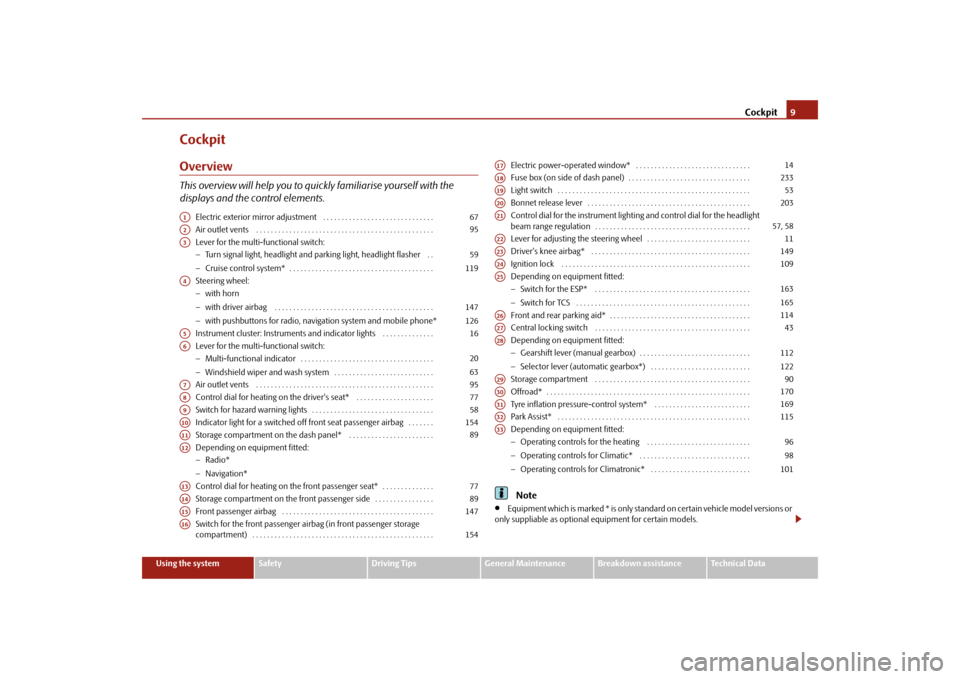
Cockpit
9
Using the system
Safety
Driving Tips
General Maintenance
Breakdown assistance
Technical Data
CockpitOverviewThis overview will help you to quic
kly familiarise yourself with the
displays and the control elements.
Electric exterior mirror adjustment . . . . . . . . . . . . . . . . . . . . . . . . . . . . . . Air outlet vents . . . . . . . . . . . . . . . . . . . . . . . . . . . . . . . . . . . . . . . . . . . . . . . . Lever for the multi-functional switch: − Turn signal light, headlight and parking light, headlight flasher . . − Cruise control system* . . . . . . . . . . . . . . . . . . . . . . . . . . . . . . . . . . . . . . . Steering wheel: − with horn − with driver airbag . . . . . . . . . . . . . . . . . . . . . . . . . . . . . . . . . . . . . . . . . . . − with pushbuttons for radio, navi
gation system and mobile phone*
Instrument cluster: Instruments and indicator lights . . . . . . . . . . . . . .Lever for the multi-functional switch: − Multi-functional indicator . . . . . . . . . . . . . . . . . . . . . . . . . . . . . . . . . . . . − Windshield wiper and wash system . . . . . . . . . . . . . . . . . . . . . . . . . . . Air outlet vents . . . . . . . . . . . . . . . . . . . . . . . . . . . . . . . . . . . . . . . . . . . . . . . .Control dial for heating on the driver's seat* . . . . . . . . . . . . . . . . . . . . . Switch for hazard warning lights . . . . . . . . . . . . . . . . . . . . . . . . . . . . . . . . . Indicator light for a switched off front seat passenger airbag . . . . . . .Storage compartment on the dash panel* . . . . . . . . . . . . . . . . . . . . . . . Depending on equipment fitted: − Radio* − Navigation* Control dial for heating on the front passenger seat* . . . . . . . . . . . . . . Storage compartment on the front passenger side . . . . . . . . . . . . . . . .Front passenger airbag . . . . . . . . . . . . . . . . . . . . . . . . . . . . . . . . . . . . . . . . . Switch for the front passenger ai
rbag (in front passenger storage
compartment) . . . . . . . . . . . . . . . . . . . . . . . . . . . . . . . . . . . . . . . . . . . . . . . . .
Electric power-operated window* . . . . . . . . . . . . . . . . . . . . . . . . . . . . . . . Fuse box (on side of dash panel) . . . . . . . . . . . . . . . . . . . . . . . . . . . . . . . . . Light switch . . . . . . . . . . . . . . . . . . . . . . . . . . . . . . . . . . . . . . . . . . . . . . . . . . . . Bonnet release lever . . . . . . . . . . . . . . . . . . . . . . . . . . . . . . . . . . . . . . . . . . . .Control dial for the instrument lighting and control dial for the headlight beam range regulation . . . . . . . . . . . . . . . . . . . . . . . . . . . . . . . . . . . . . . . . . . Lever for adjusting the steering wheel . . . . . . . . . . . . . . . . . . . . . . . . . . . .Driver's knee airbag* . . . . . . . . . . . . . . . . . . . . . . . . . . . . . . . . . . . . . . . . . . . Ignition lock . . . . . . . . . . . . . . . . . . . . . . . . . . . . . . . . . . . . . . . . . . . . . . . . . . . Depending on equipment fitted:− Switch for the ESP* . . . . . . . . . . . . . . . . . . . . . . . . . . . . . . . . . . . . . . . . . . − Switch for TCS . . . . . . . . . . . . . . . . . . . . . . . . . . . . . . . . . . . . . . . . . . . . . . . Front and rear parking aid* . . . . . . . . . . . . . . . . . . . . . . . . . . . . . . . . . . . . . . Central locking switch . . . . . . . . . . . . . . . . . . . . . . . . . . . . . . . . . . . . . . . . . .Depending on equipment fitted: − Gearshift lever (manual gearbox) . . . . . . . . . . . . . . . . . . . . . . . . . . . . . . − Selector lever (automatic gearbox*) . . . . . . . . . . . . . . . . . . . . . . . . . . . Storage compartment . . . . . . . . . . . . . . . . . . . . . . . . . . . . . . . . . . . . . . . . . . Offroad* . . . . . . . . . . . . . . . . . . . . . . . . . . . . . . . . . . . . . . . . . . . . . . . . . . . . . . . Tyre inflation pressure-control system* . . . . . . . . . . . . . . . . . . . . . . . . . .Park Assist* . . . . . . . . . . . . . . . . . . . . . . . . . . . . . . . . . . . . . . . . . . . . . . . . . . . . Depending on equipment fitted: − Operating controls for the heating . . . . . . . . . . . . . . . . . . . . . . . . . . . . − Operating controls for Climatic* . . . . . . . . . . . . . . . . . . . . . . . . . . . . . . − Operating controls for Climatronic* . . . . . . . . . . . . . . . . . . . . . . . . . . .Note
•
Equipment which is marked * is only standa
rd on certain vehicl
e model versions or
only suppliable as optional
equipment for certain models.
A1
67
A2
95
A3
59 119
A4
147126
A5
16
A6
2063
A7
95
A8
77
A9
58
A10
154
A11
89
A12A13
77
A14
89
A15
147
A16
154
A17
14
A18
233
A19
53
A20
203
A21
57, 58
A22
11
A23
149
A24
109
A25
163165
A26
114
A27
43
A28
112122
A29
90
A30
170
A31
169
A32
115
A33
9698101
sgg.6.book Page 9 Thursda
y, September 24, 2009 2:32 PM
Page 15 of 271
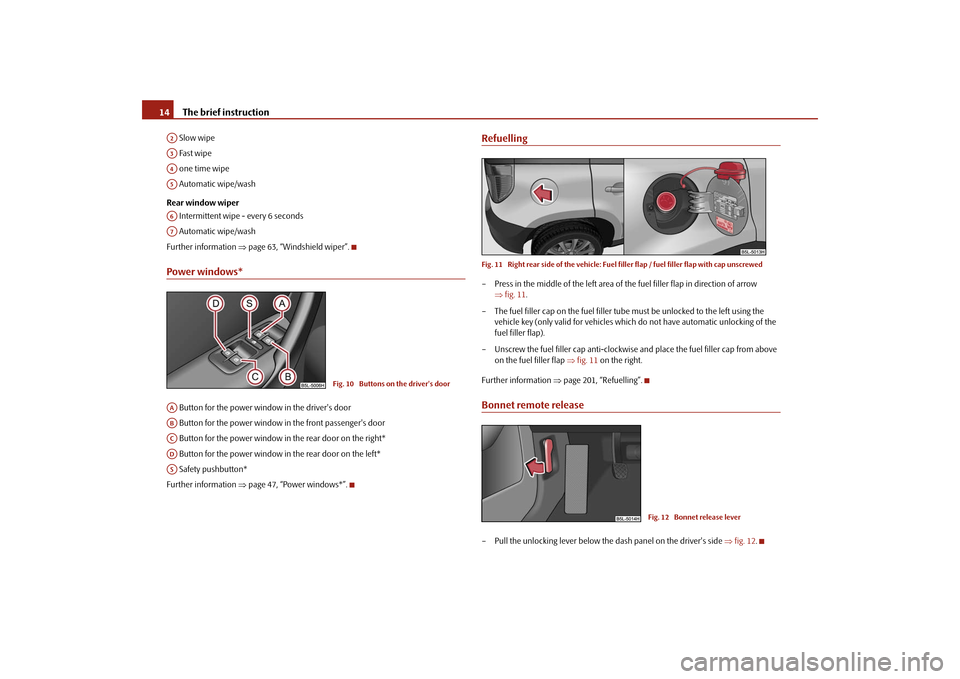
The brief instruction
14
Slow wipe Fast wipe one time wipe Automatic wipe/wash Rear window wiper Intermittent wipe - every 6 seconds Automatic wipe/washFurther information
⇒page 63, “Windshield wiper”.
Power windows* Button for the power window in the driver's door Button for the power window in the front passenger's door Button for the power window in the rear door on the right* Button for the power window in the rear door on the left* Safety pushbutton*Further information
⇒page 47, “Power windows*”.
RefuellingFig. 11 Right rear side of the vehicle: Fuel
filler flap / fuel filler flap with cap unscrewed
– Press in the middle of the left area of the fuel filler flap in direction of arrow
⇒ fig. 11
.
– The fuel filler cap on the fuel filler tube
must be unlocked to the left using the
vehicle key (only valid for vehicles which
do not have automatic unlocking of the
fuel filler flap).
– Unscrew the fuel filler ca
p anti-clockwise and place the fuel filler cap from above
on the fuel filler flap
⇒fig. 11
on the right.
Further information
⇒page 201, “Refuelling”.
Bonnet remote release– Pull the unlocking lever below the dash panel on the driver's side
⇒fig. 12
.
A2A3A4A5A6A7
Fig. 10 Buttons on the driver's door
AAABACADAS
Fig. 12 Bonnet release lever
sgg.6.book Page 14 Thursday, September 24, 2009 2:32 PM
Page 21 of 271

Instruments and Indicator/Warning Lights
20Digital clockThe time is set with the buttons and
⇒page 16, fig. 15
.
Select the display which you wish to chan
ge with the button and carry out the
change with the button . On vehicles which are fitted out with the info
rmation display*, it is possible to set the
time in the menu
Time
⇒page 27.
WARNING
The clock should not be adjusted while dr
iving for safety reasons but only when
the vehicle is stationary!Multi-functional indicator (onboard computer)IntroductionThe multi-functional indicator appears in the display
⇒fig. 18
or in the information
display
⇒page 24 depending on the equipm
ent fitted to your vehicle.
The multi-functional indicator offers
you a range of us
eful information.
On vehicles which are fitted ou
t with information display*, it is possible to switch off
the display of some information.
Caution
Pull out the ignition key while having co
ntact with the display (for example when
cleaning) in order to prevent any damage.
Note
•
In certain national versions the displays appear in the Imperial system of measures.
•
If the display of the second speed is acti
vated in mph, the current speed* is not
indicated in km/h on the display.MemoryThe multi-functional indicator is equi
pped with two automatic memories. The
selected memory is displayed in
the middle of the display field
⇒fig. 18
.
The data of the single-trip memory (memory 1) is shown if a
1 appears in the display.
A 2 shown in the display means that data
relates to the total distance memory
(memory 2). Switching over the memory with the help of the button
⇒page 21, fig. 19
on the
windscreen wiper lever or with the help of the button on the multifunction steering wheel*
⇒page 21.
The outside temperature
⇒page 22
Driving time
⇒page 22
Current fuel consumption
⇒page 22
Average fuel consumption
⇒page 22
Range
⇒page 22
Distance driven
⇒page 23
Average speed
⇒page 23
Current speed*
⇒page 23
Oil temperature
⇒page 23
Warning against excessive speeds*
⇒page 23
A3
A7
A3
A7
Fig. 18 Multi-functional indicator
AB
AD
sgg.6.book Page 20 Thursday, September 24, 2009 2:32 PM
Page 22 of 271
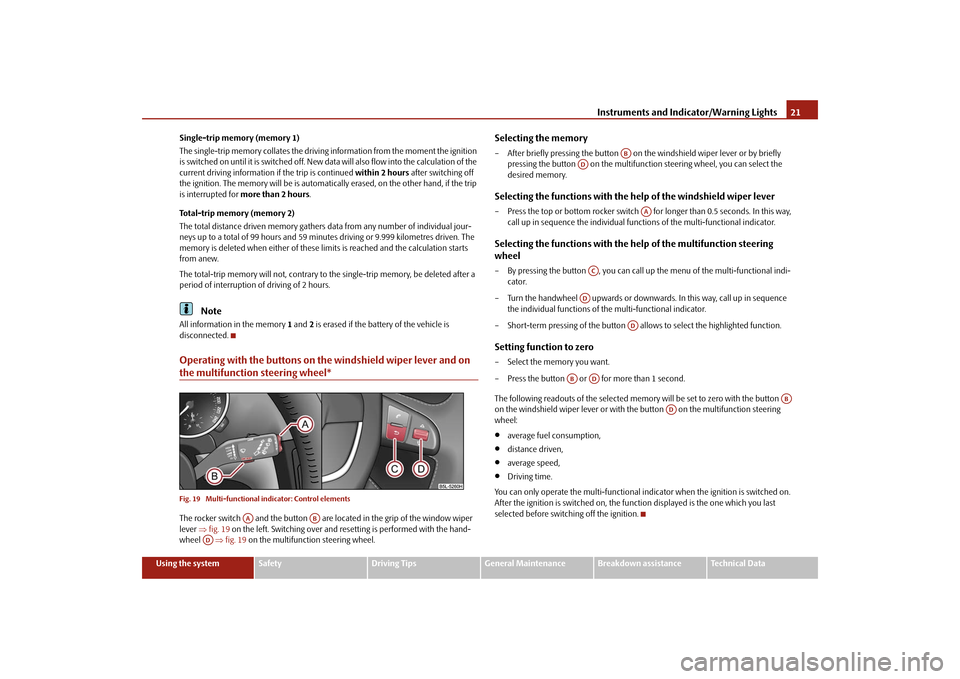
Instruments and Indicator/Warning Lights
21
Using the system
Safety
Driving Tips
General Maintenance
Breakdown assistance
Technical Data
Single-trip memory (memory 1) The single-trip memory collates the driving information from the moment the ignition is switched on until it is switched off. New data will also flow into the calculation of the current driving information if the trip is continued
within 2 hours
after switching off
the ignition. The memory will be is automatically erased, on the other hand, if the trip is interrupted for
more than 2 hours
.
Total-trip memory (memory 2) The total distance driven memory gathers da
ta from any number of individual jour-
neys up to a total of 99 hours and 59 minutes driving or 9.999 kilometres driven. The memory is deleted when either of these limits is reached and the calculation starts from anew. The total-trip memory will not, contrary to
the single-trip memory, be deleted after a
period of interr
uption of driving of 2 hours.
Note
All information in the memory
1 and
2 is erased if the battery of the vehicle is
disconnected.Operating with the buttons on the windshield wiper lever and on the multifunction steering wheel*Fig. 19 Multi-functional indicator: Control elementsThe rocker switch and the button are lo
cated in the grip of the window wiper
lever
⇒fig. 19
on the left. Switching over and resetting is performed with the hand-
wheel
⇒fig. 19
on the multifunction steering wheel.
Selecting the memory– After briefly pressing the button on
the windshield wiper lever or by briefly
pressing the button on the multifuncti
on steering wheel, you can select the
desired memory.
Selecting the functions with the he
lp of the windshield wiper lever
– Press the top or bottom rocker switch
for longer than 0.5 seconds. In this way,
call up in sequence the individual func
tions of the multi-functional indicator.
Selecting the functions with the
help of the multifunction steering
wheel– By pressing the button , you can call up
the menu of the multi-functional indi-
cator.
– Turn the handwheel upwards or downward
s. In this way, call up in sequence
the individual functions of th
e multi-functional indicator.
– Short-term pressing of the button allows to select the highlighted function.Setting function to zero– Select the memory you want.– Press the button or for more than 1 second. The following readouts of the selected memo
ry will be set to zero with the button
on the windshield wiper lever or with the button on the multifunction steering wheel:•
average fuel consumption,
•
distance driven,
•
average speed,
•
Driving time.
You can only operate the multi-functional in
dicator when the igniti
on is switched on.
After the ignition is switched on, the function displayed is the one which you last selected before switching off the ignition.
AA
AB
AD
AB
AD
AA
AC
AD
AD
AB
AD
AB
AD
sgg.6.book Page 21 Thursday, September 24, 2009 2:32 PM
Page 25 of 271

Instruments and Indicator/Warning Lights
24Information display*IntroductionThe information display provides you with information in a convenient way concerning the
current operating state of your vehicle
. The information system also
provides you with data (depending on the equipment installed in the vehicle) relating to the radio, mobile phone, multi-function
al indicator, naviga
tion system, the unit
connected to the MDI input and the automatic gearbox. Certain functions and operating conditions
are always being checked on the vehicle
when the ignition is switched on and also while driving. Functional faults, if required
repair work and other information are indicated by red
symbols
⇒page 26 and yellow symbols
⇒page 27.
Lighting up of certain symbols is combined with an acoustic warning signal.Information and texts giving warnings
are also shown in the display
⇒page 29.
The display of text is possible in the following languages:
Czech, English, German, French, Italian,
Spanish, Portuguese, Russian and Chinese.
You can select the desired language in the setting menu.The following information can be shown in
the display (depending on the equipment
installed on the vehicle):
Caution
Pull out the ignition key while having co
ntact with the display (for example when
cleaning) in order to prevent any damage.Main menuFig. 23 Information display: Controls on the wi
ndshield wiper lever /
controls on the multi-
function steering wheelOperating with the buttons on the windshield wiper lever– You can activate the
MAIN MENU
by pressing the rocker switch
⇒fig. 23
for
more than 1 second.
– You can select indi
vidual menu points by means of the rocker switch . When the
pushbutton is briefly pressed, the info
rmation you have selected is displayed.
Operating with the buttons on the multifunction steering wheel*– You can call up the
MAIN MENU
by pressing the button
⇒fig. 23
.
Fig. 22 Instrument cluster: Information display
Main menu
⇒ page 24
Door, luggage compartment door and bonnet ajar warn- ing
⇒ page 25
Service Interval Display
⇒page 18
Selector lever positions for the automatic gearbox DSG
⇒page 122AAAA
AB
AC
sgg.6.book Page 24 Thursday, September 24, 2009 2:32 PM
Page 44 of 271
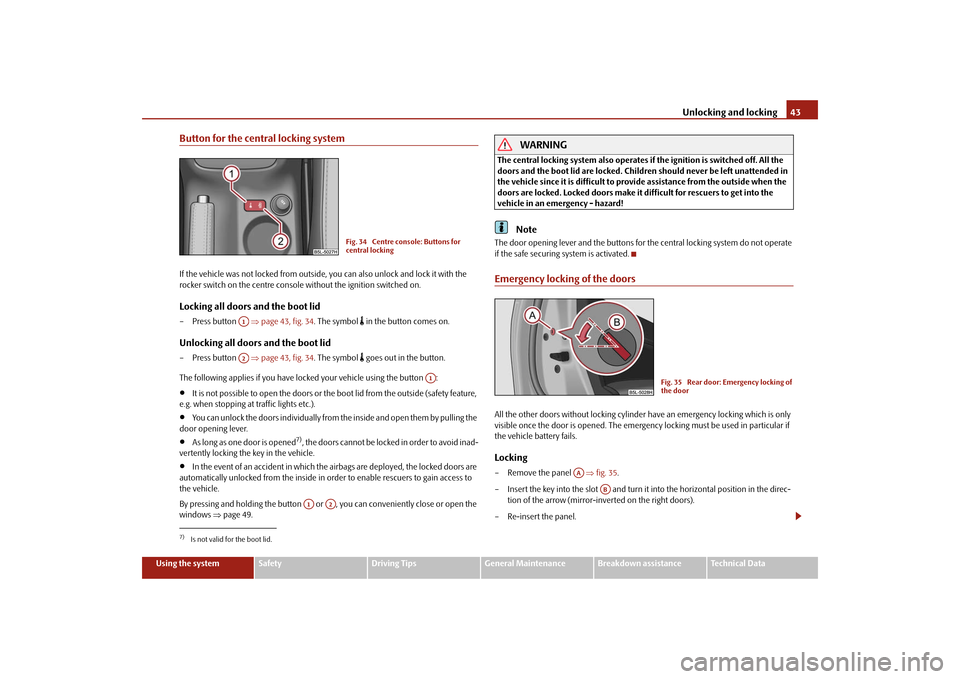
Unlocking and locking
43
Using the system
Safety
Driving Tips
General Maintenance
Breakdown assistance
Technical Data
Button for the central locking systemIf the vehicle was not locked from outside,
you can also unlock and lock it with the
rocker switch on the centre consol
e without the ignition switched on.
Locking all doors and the boot lid– Press button
⇒page 43, fig. 34
. The symbol
in the button comes on.
Unlocking all doors and the boot lid– Press button
⇒page 43, fig. 34
. The symbol
goes out in the button.
The following applies if
you have locked your vehicle using the button :
•
It is not possible to open the doors or the boot lid from the outside (safety feature,
e.g. when stopping at traffic lights etc.).•
You can unlock the doors individually from the inside and open them by pulling the
door opening lever.•
As long as one door is opened
7), the doors cannot be locked in order to avoid inad-
vertently locking the key in the vehicle.•
In the event of an accident in which the airbags are deployed, the locked doors are
automatically unlocked from the inside in orde
r to enable rescuers to gain access to
the vehicle. By pressing and holding the button or ,
you can conveniently close or open the
windows
⇒page 49.
WARNING
The central locking system al
so operates if the ignition is switched off. All the
doors and the boot lid are locked. Children should never be left unattended in the vehicle since it is difficult to prov
ide assistance from the outside when the
doors are locked. Locked doors make it difficult for rescuers to get into the vehicle in an emergency - hazard!
Note
The door opening lever and the buttons for
the central locking system do not operate
if the safe securing system is activated.Emergency locking of the doorsAll the other doors without locking cylinder
have an emergency locking which is only
visible once the door is opened. The emergenc
y locking must be used in particular if
the vehicle battery fails.Locking– Remove the panel
⇒fig. 35
.
– Insert the key into the slot and turn it
into the horizontal position in the direc-
tion of the arrow (mirror-inverted on the right doors).
– Re-insert the panel.
7)Is not valid for the boot lid.
Fig. 34 Centre console: Buttons for central locking
A1A2
A1
A1
A2
Fig. 35 Rear door: Emergency locking of the door
AA
AB
sgg.6.book Page 43 Thursday, September 24, 2009 2:32 PM
Page 47 of 271
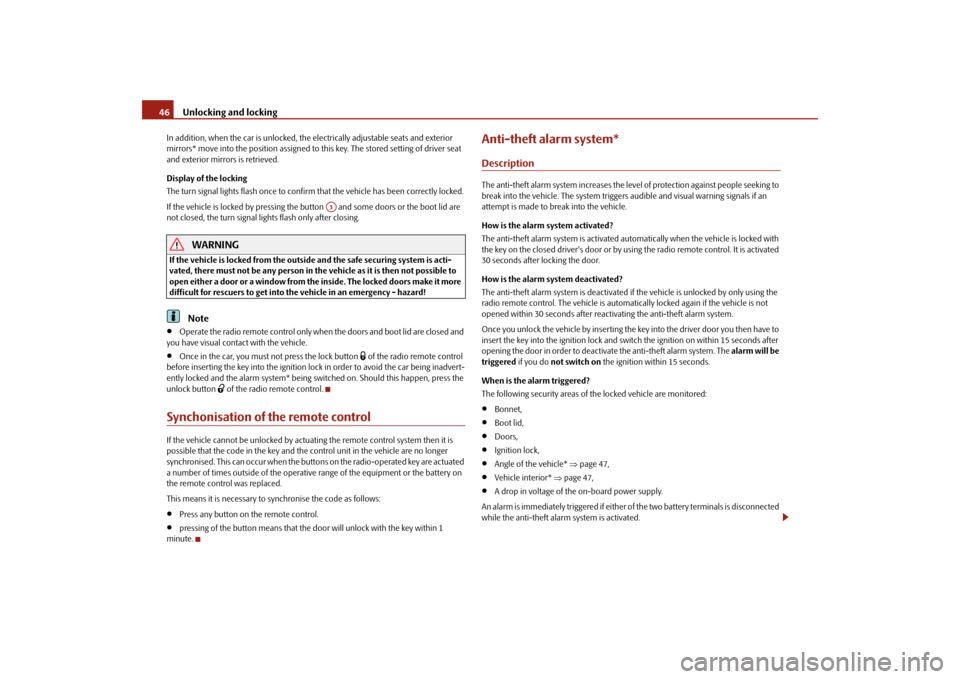
Unlocking and locking
46In addition, when the car is unlocked, the electrically adjustable seats and exterior mirrors* move into the position assigned to this key. The stored setting of driver seat and exterior mirrors is retrieved. Display of the locking The turn signal lights flash once to confir
m that the vehicle has been correctly locked.
If the vehicle is locked by pr
essing the button and some doors or the boot lid are
not closed, the turn signal lights flash only after closing.
WARNING
If the vehicle is locked from the outside and the safe securing system is acti-vated, there must not be any person in the vehicle as it is then not possible to open either a door or a window from the inside. The locked doors make it more difficult for rescuers to get into th
e vehicle in an emergency - hazard!
Note
•
Operate the radio remote control only when
the doors and boot lid are closed and
you have visual contact with the vehicle.•
Once in the car, you must
not press the lock button
of the radio remote control
before inserting the key into the ignition lock in order to avoid the car being inadvert- ently locked and the alarm system* being switched on. Should this happen, press the unlock button
of the radio remote control.
Synchonisation of the remote controlIf the vehicle cannot be unlocked by actuatin
g the remote control system then it is
possible that the code in the key and the co
ntrol unit in the vehicle are no longer
synchronised. This can occur when the buttons on the radio-operated key are actuated a number of times outside of the operative
range of the equipment or the battery on
the remote control was replaced. This means it is necessary to
synchronise the code as follows:
•
Press any button on the remote control.
•
pressing of the button means that the d
oor will unlock with the key within 1
minute.
Anti-theft alarm system*DescriptionThe anti-theft alarm system increases the level of protection against people seeking to break into the vehicle. The system triggers audible and visual warning signals if an attempt is made to break into the vehicle. How is the alarm
system activated?
The anti-theft alarm system is activated au
tomatically when the vehicle is locked with
the key on the closed driver's door or by us
ing the radio remote control. It is activated
30 seconds after locking the door. How is the alarm system deactivated? The anti-theft alarm system is deactivated if
the vehicle is unlocked by only using the
radio remote control. The vehicle is automati
cally locked again if the vehicle is not
opened within 30 seconds after reactivating the anti-theft alarm system. Once you unlock the vehicle by inserting the ke
y into the driver door you then have to
insert the key into the ignition lock and sw
itch the ignition on within 15 seconds after
opening the door in order to deactivate the anti-theft alarm system. The
alarm will be
triggered
if you do
not switch on
the ignition within 15 seconds.
When is the alarm triggered? The following security areas of
the locked vehicle are monitored:
•
Bonnet,
•
Boot lid,
•
Doors,
•
Ignition lock,
•
Angle of the vehicle*
⇒page 47,
•
Vehicle interior*
⇒page 47,
•
A drop in voltage of the on-board power supply.
An alarm is immediately triggered if either of the two battery terminals is disconnected while the anti-theft alarm system is activated.
A3
sgg.6.book Page 46 Thursday, September 24, 2009 2:32 PM
Page 48 of 271
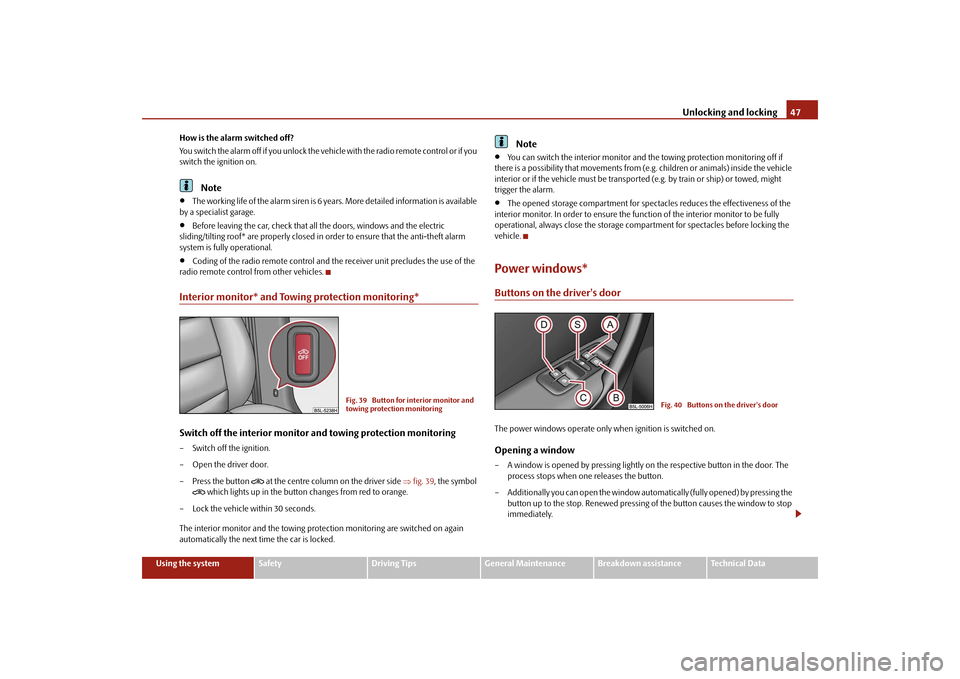
Unlocking and locking
47
Using the system
Safety
Driving Tips
General Maintenance
Breakdown assistance
Technical Data
How is the alarm switched off? You switch the alarm off if you unlock the vehi
cle with the radio remote control or if you
switch the ignition on.
Note
•
The working life of the alarm siren is 6 years. More detailed information is available
by a specialist garage.•
Before leaving the car, check that all the doors, windows and the electric
sliding/tilting roof* are properly closed in order to ensure that the anti-theft alarm system is fully operational.•
Coding of the radio remote control and th
e receiver unit precludes the use of the
radio remote control from other vehicles.Interior monitor* and Towing protection monitoring*Switch off the interior monitor and towing protection monitoring– Switch off the ignition. – Open the driver door.– Press the button
at the centre column on the driver side
⇒fig. 39
, the symbol
which lights up in the button changes from red to orange.
– Lock the vehicle within 30 seconds. The interior monitor and the towing protec
tion monitoring are switched on again
automatically the next time the car is locked.
Note
•
You can switch the interior monitor and th
e towing protection monitoring off if
there is a possibility that movements from (e.g. children or animals) inside the vehicle interior or if the vehicle must be transpor
ted (e.g. by train or ship) or towed, might
trigger the alarm.•
The opened storage compartment for spectacles reduces the effectiveness of the
interior monitor. In order to ensure the func
tion of the interior
monitor to be fully
operational, always close the storage comp
artment for spectacles before locking the
vehicle.Power windows*Buttons on the driver's doorThe power windows operate only when ignition is switched on.Opening a window – A window is opened by pressing lightly on the respective button in the door. The
process stops when one releases the button.
– Additionally you can open the window auto
matically (fully open
ed) by pressing the
button up to the stop. Renewed pressing of
the button causes the window to stop
immediately.
Fig. 39 Button for interior monitor and towing protection monitoring
Fig. 40 Buttons on the driver's door
sgg.6.book Page 47 Thursday, September 24, 2009 2:32 PM
Page 49 of 271
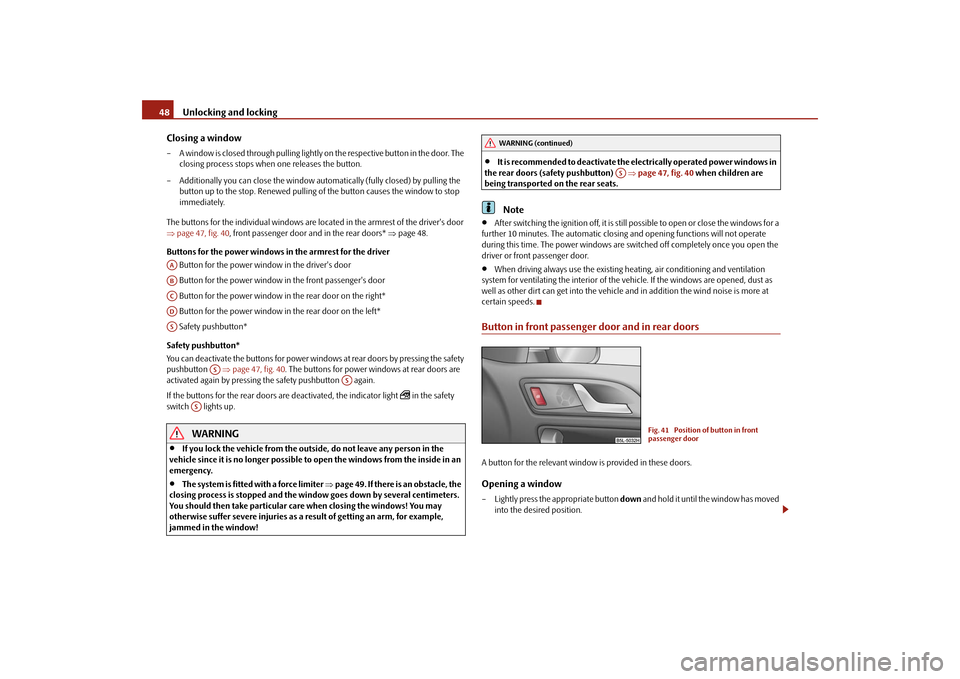
Unlocking and locking
48 Closing a window– A window is closed through pulling lightly on the respective button in the door. The
closing process stops when
one releases the button.
– Additionally you can close the window auto
matically (fully clos
ed) by pulling the
button up to the stop. Renewed pulling of the button causes the window to stop immediately.
The buttons for the individual windows are located in the armrest of the driver's door ⇒ page 47, fig. 40
, front passenger door and in the rear doors*
⇒page 48.
Buttons for the power windows in the armrest for the driver Button for the power window in the driver's door Button for the power window in the front passenger's door Button for the power window in the rear door on the right* Button for the power window in the rear door on the left* Safety pushbutton* Safety pushbutton* You can deactivate the buttons for power wind
ows at rear doors by pressing the safety
pushbutton
⇒page 47, fig. 40
. The buttons for power windows at rear doors are
activated again by pressing
the safety pushbutton again.
If the buttons for the rear doors are deactivated, the indicator light
in the safety
switch lights up.
WARNING
•
If you lock the vehicle from the outside, do not leave any person in the
vehicle since it is no longer possible to
open the windows from the inside in an
emergency.•
The system is fitted with a force limiter
⇒page 49. If there is an obstacle, the
closing process is stopped and the window
goes down by several centimeters.
You should then take particular care when closing the windows! You may otherwise suffer severe injuries as a re
sult of getting an arm, for example,
jammed in the window!
•
It is recommended to deactivate the el
ectrically operated
power windows in
the rear doors (safety pushbutton)
⇒page 47, fig. 40
when children are
being transported on the rear seats.
Note
•
After switching the ignition off, it is still
possible to open or close the windows for a
further 10 minutes. The automatic closing and opening functions will not operate during this time. The power windows are sw
itched off completely once you open the
driver or front passenger door.•
When driving always use the existing he
ating, air conditioning and ventilation
system for ventilating the interior of the vehicle. If the windows are opened, dust as well as other dirt can get into the vehicle an
d in addition the wind noise is more at
certain speeds.Button in front passenger door and in rear doorsA button for the relevant window is provided in these doors.Opening a window– Lightly press the appropriate button
down
and hold it until the window has moved
into the desired position.
AAABACADAS
AS
AS
AS
WARNING (continued)
AS
Fig. 41 Position of button in front passenger door
sgg.6.book Page 48 Thursday, September 24, 2009 2:32 PM
Page 72 of 271

Seats and Stowage
71
Using the system
Safety
Driving Tips
General Maintenance
Breakdown assistance
Technical Data
•
The seat backrests must not be angled too far back when driving otherwise
this will affect proper operation of the se
at belts and of the airbag system - risk
of injury!
Note
If the movement of the seat is inadverten
tly interrupted during an adjustment, once
again press the switch in the appropriate di
rection and continue with the adjustment
of the seat to the end.Storing settingStoring seat and exterior mirror settings for driving forward– Switch on the ignition. – Adjust the seat
⇒page 70.
– Adjust both exterior mirrors
⇒page 67.
– Press button
SET
⇒fig. 64
.
– Press one of the memory buttons with
in 10 seconds after pressing the button
SET
- an acknowledgement signal confirms that the seat setting is stored.
Storing exterior mirror setting for reversing*– Switch on the ignition.
– Turn the exterior mirror control to position
⇒page 67.
– Engage the reverse gear. – Move the right exterior mirror
into the desired position
⇒page 67.
– Take the vehicle out of gear. The set posi
tion of the exterior mirror is stored.
Memory buttons Memory for the seat offers the possibility to store the individual driver seat and external mirror position. An individual posi
tion can be allocated to each of the three
memory buttons
⇒fig. 64
, that is three in total. Af
ter pressing the corresponding
memory button , the seat and the exterior
mirror are automatically moved into the
positions which have been allocated to this button
⇒page 71.
Emergency Off You can interrupt the setting operation at any time, if you operate any button of the driver seat.
Note
•
For safety reasons, it is not possible to store this position if the inclination angle of
the seat backrest is more than 102
° in relation to the seat cushion.
•
When storing settings with the memory
buttons, we recommend that you begin
with the front button and assign a memory button to each additional driver.•
Each new setting stored with the same button erases the previous setting.
•
Each time you store the seat and exterior mirror settings for driving forward you
also have to re-store the individual setting
of the exterior mirror on the passenger side
for reversing.Assigning remote control to the memory buttonsAfter storing the settings of the seat and exterior mirrors, you have 10 seconds in order to assign the radio remote control to the appropriate memory button. – Withdraw the ignition key.
WARNING (continued)
Fig. 64 Driver seat: Memory buttons and SET button
AA
AB
ABAB
sgg.6.book Page 71 Thursday, September 24, 2009 2:32 PM